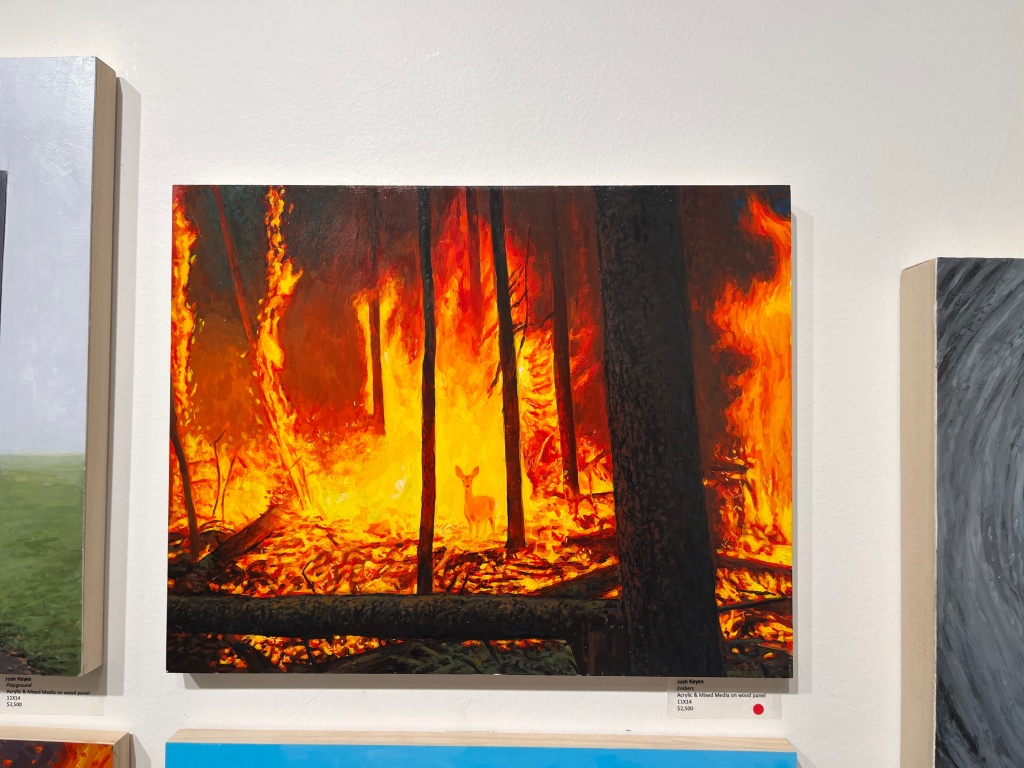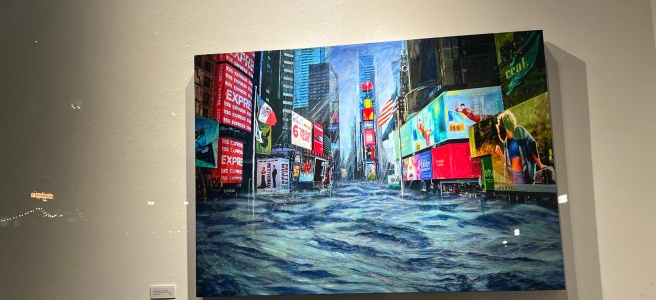“An artist’s duty, as far as I’m concerned, is to reflect the times,” said musician Nina Simone. And so today the products of a warming planet are taking center stage in galleries around the country. It’s common to see paintings of floods, fires, and other calamities experienced or imagined through the eyes of artists.
They have a grand tradition to fall on. J.M.W. Turner’s The Burning of the Houses of Lords and Commons comes to mind. Historical works have depicted volcanic eruptions, shipwrecks, or tsunamis. It’s not the first time in history artists have taken on the subject of climate change either, but this is the first time we are the cause. Never before has the threat before us been universally existential.
If a warming planet is such a threat, why can’t we muster the will to combat it? One answer may lie in modernism and how it has desensitized us to an onslaught of disruption.
When Marshall Berman’s book on modernity, All That’s Solid Melts Into Air, was published in 1982, a nuclear holocaust was a far bigger concern than climate change.
Consider this passage from Berman’s introduction… “To be modern is to find ourselves in an environment that promises us adventure, power, joy, growth, transformation of ourselves and the world at the same time, that threatens to destroy everything we have, everything we know, everything we are.”
And so today we are faced on one hand with a century or more of continual destruction, disruption, and re-creation that perhaps makes the sudden onslaught of climate collapse not so different than the automobile, personal computer, artificial intelligence, or never-ending desire to be groundbreaking with our art. We can no more turn to stop it than we can return to painting landscapes and still lifes.
All that modernity affords us is proving to be too much to give up to save our fragile home. Our cultural self-preservation also depends on the burning of carbon and we can’t turn off the economic engine to save ourselves. Technological solutions have come to our rescue in the past, but may not arrive soon enough to save us this time. The process of migration, rebuilding, reinforcing, and ignoring continues as we hope for a miracle, but not really expecting one.
Currently, at Waterstone Gallery in Portland, Sabina Haque’s work is presented as “The New Abnormal.” Among the paintings are those featuring a tree covered in webbing. “Those are created by insects that come into the tree to get out of the water,” another gallery artist explained. Featuring Oregon fires and Pakistan floods, the works explore destruction, renewal, and possible paths forward through a sometimes unrecognizable landscape.
To be undeterred is to paint destruction, and at once on some level, find beauty in that destruction. The cover work, Portal to a Before Time, asks us to look through the destruction a few years back when these disasters weren’t so commonplace. Similar to the way modernity and innovation ask us to constantly imagine a technologically advanced future, we are also faced with looking forward to a future where the destruction is many times worse than it is today.

Another recent exhibit embracing the subject was Josh Keyes’ TRAUMA at Brassworks Gallery. Many of these paintings focus on animals, the innocent victims of human-induced climate change. A deer gazing at us through the flames in a burning forest; and a polar bear struggling to swim as he is circled by sharks – these paintings seem to warn of what’s coming in our future.
Then there’s the shopping cart carrying a human skeleton. Our consumerism is surely leading us to our doom, yet we can’t resist. The paintings urge precaution, but like gun violence, as disasters unfold, we forget what it was like to live without them.
Jane Jacobs warns how collective memory can be lost in her 2004 book Dark Age Ahead. Haque’s idea of a portal to what was may be essential in the coming years as “even the memory of what was lost can be lost.”
To Jacobs, the culprit is ideology, which provides a cookie-cutter approach to dealing with problems as they arise. Armed with these ideologies, easy “answers” are at our fingertips. At the same time, they prevent us from finding rational and scientifically verifiable explanations and solutions.
Even if the world wasn’t facing peril, art that shows more than the beauty around us is essential. Maybe on some level, art can make a difference. Maybe it can’t. But at the present juncture, for some artists, there’s no subject matter more important.
“So I don’t think you have a choice,” Simone said. “How can you be an artist and NOT reflect the times?”
Discover more from Urban Art & Antiques
Subscribe to get the latest posts sent to your email.


